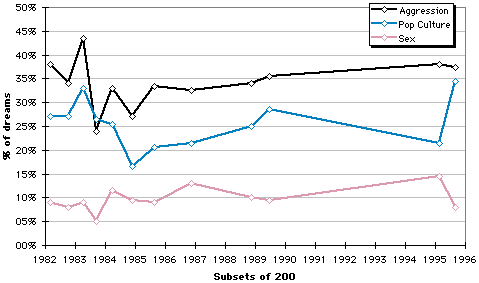George Weldon: The Consistency of Aggression, Sexuality, and Pop Culture in a Long Dream Series
George Weldon (not his real name) has sent us more than 2400 dream reports
from 1981 through 1996. During that time span George has gone from age 18 to
age 32. We wanted to see if the content of his dreams would remain consistent
over that time or whether there would be wild fluctuations.
Because of the massive amount of data presented to us in this study, there
was no way we could have coded George's dreams using every single Hall/Van de
Castle category. The only way to make a study feasible was to select a few
elements and simply count how many dreams contained them. We chose
aggression because it is easy to code and quite common. We picked sexuality
because it is very easy to code, and moreover, we might expect
fluctuations in the sexual content of people's dreams as they mature, meet
new lovers, break up, etc.
The third category we examined was "pop culture." We invented this category
specifically for this study because we noticed that George's dreams contained
many references to pop music, television, movies, comic books, etc. In fact,
in many of his dreams, George was interacting with famous actors or fictional
characters, or he was actually in a TV show, movie, or comic book.
Because these pop culture references were so frequent in his dreams, we
thought it would make a good topic of study. Unfortunately, there are no
norms to which we could compare our findings on George. But, as long as we
carefully operationalized our definition of the new pop culture category, it
was a perfectly valid measure with which to measure consistency.
Aside from the raw numbers, there are two larger reasons we are publicizing
the results of this study:
- First, it shows that you can plow through incredible amounts of dream
data (such as a dream series that spans several years) by using the "at least
one" method of coding. That is, all you have to do is count how many dream
reports contain "at least one" of some coding element, and you can do an
excellent study with much less tedious busywork than it would take to do a complete
content analysis.
- Second, we have demonstrated that you can create new categories if need
be. If you do this, you must clearly define the coding rules and then make
sure that you have good intercoder reliability. The drawback, of course,
is that there will be no norms to compare your new measure to.
Now let's get back to George Weldon. The graph below shows the results of breaking up all the dreams into twelve sets of 200 dreams each. (The dates along the horizontal axis are the mean dates of each subset.) There are a few interesting things to point out:
- For the most part, the percentages of dreams containing our three
categories did not vary too much (although the amount of aggression
fluctuated somewhat during George's college years). In other words, there
was quite good consistency over the 15 years.
- With the exception of a "blip" in 1984, the order of the three
content categories remained the same; there were almost always more dream
reports with aggression than pop culture, and always more with pop culture
than sex.
- The findings on aggression are a little below the male norms (47%);
the findings on sexuality are very close to the male norms (12%).
| George Weldon: Dreams with Aggression,
Pop Culture, and Sexuality by Subsets of 200, 1981-1996
| 
|
 Go back to the Findings index. Go back to the Findings index.
|